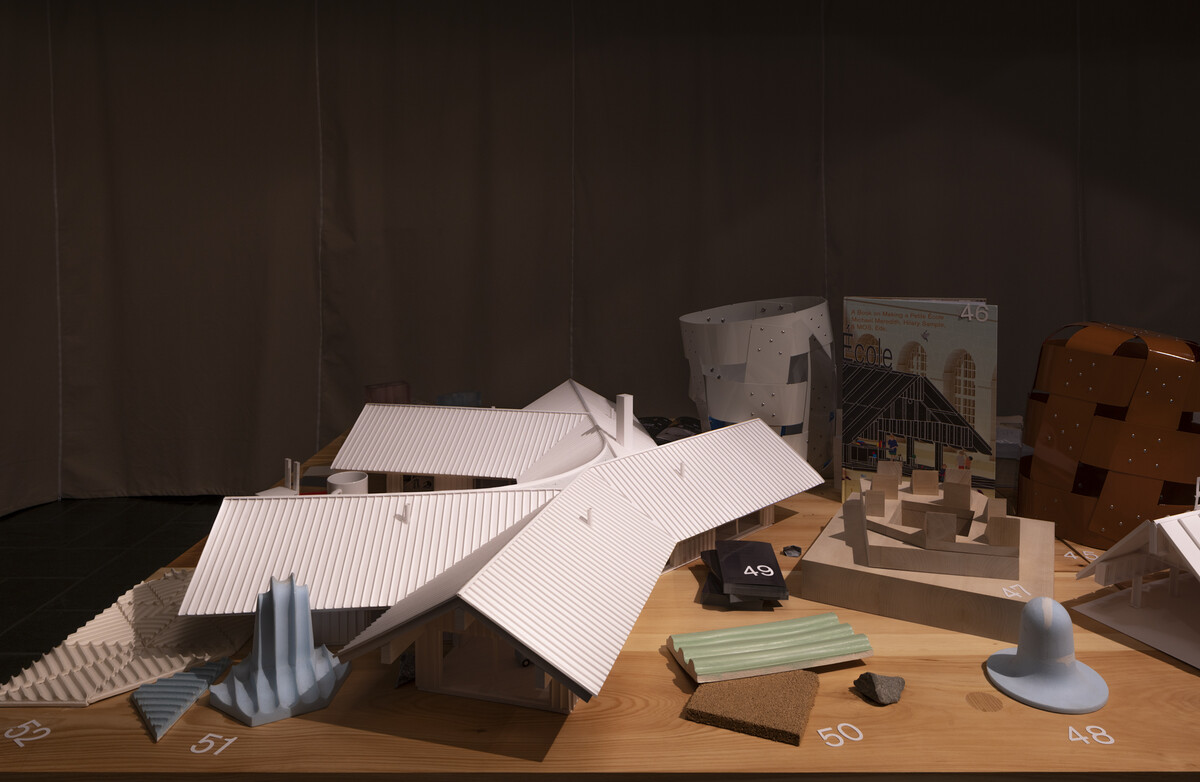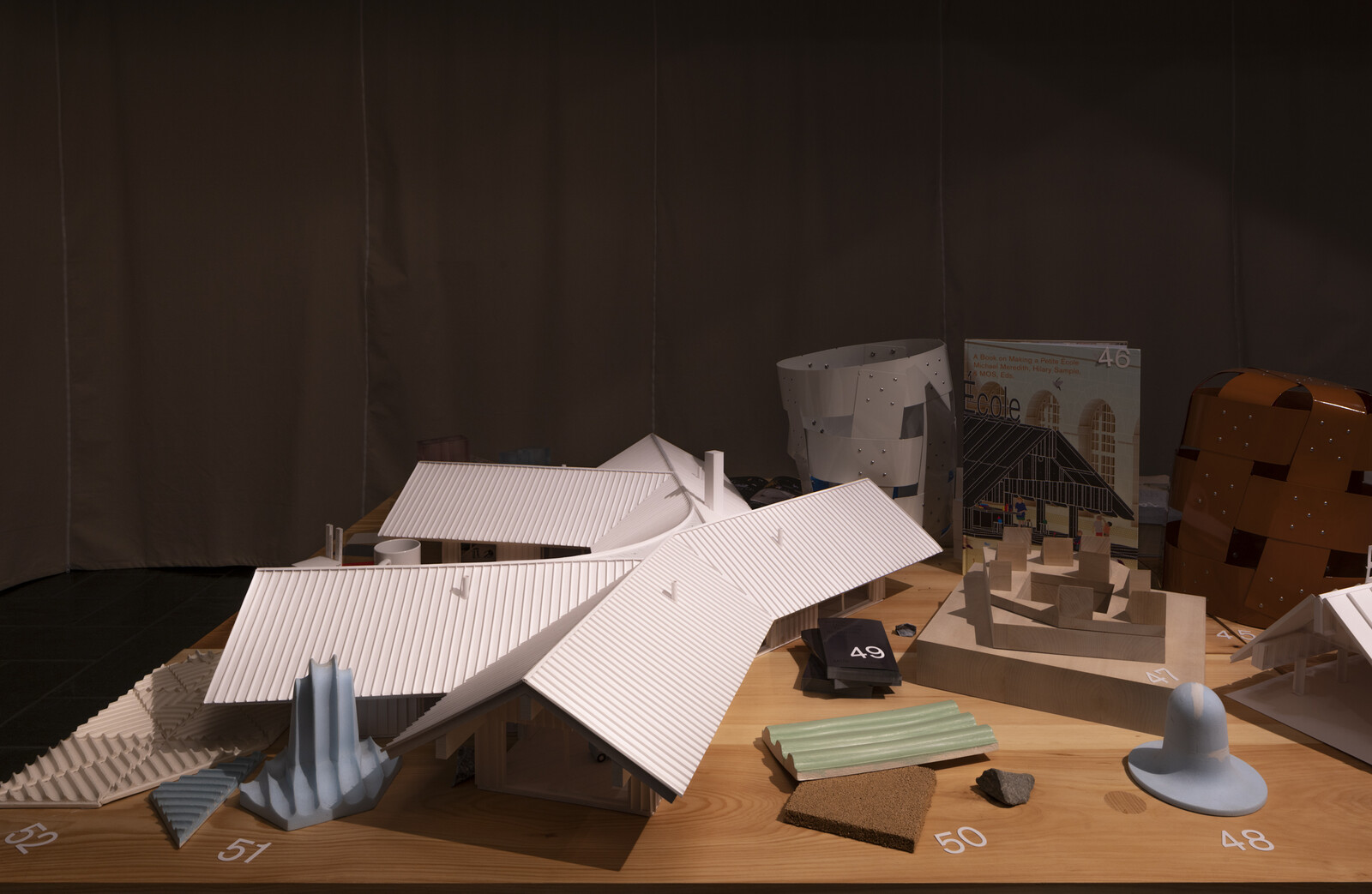(662) MOS ARCH
February 22–April 22, 2022
Text (662) 667 2724 for info.
Curatorial statement
This exhibition presents the remains of an architectural office: a collection of objects—prototypes, books, sketches, models, notes, drawings, experiments, material swatches, paper with a concentration on smallness and smaller-scale work. The organization of the exhibition mirrors our little office, with a large table where things accumulate. Nothing is separated into categories or organized by project or theme. Everything simply exists together as part of a landscape of things that are made, with multiple scales, formats, happening in parallel and in conversation by their proximity.
When assembling work for the exhibition, we thought about our work as a sort of spam, spam architecture. As the artist Hito Steyerl writes in “Digital Debris: Spam and Scam,” “Contemporary electronic spam tries to extract an improbable spark of value from an inattentive crowd by means of inundation. But to become spam—that is, to fully identify with its unrealized promise—means to spark an improbable element of commonality between different forms of existence, to become a public thing, a cheerful incarnation of data-based wreckage.” While architecture is obviously different from spam, spam architecture is repetitive, inexpensive, and without signature. It circulates, relying on representation. And once you start looking for it, it is everywhere. The general mode of disciplinary communication as well as protest, theory, commentary, and self-promotion appear similar, as spam. Everything arrives, notifying us of its arrival. Everything tries to hold our attention. And then everything is quickly replaced by the next thing, and the next, ad infinitum. A lot of architectural representations circulating today feel like spam. MOS makes a lot of stuff, all the time, many times without clients, on many platforms, through various media. We ourselves are constantly reaching out, in the hope of finding a common ground within our fragmented attention. We produce spam architecture. And perhaps paradoxically, as much as we spam, architecture’s physicality, collaboration, and use (both functional and cultural) make it unlike spam. Although architecture repeats and circulates, it doesn’t need to constantly notify the world about what it is doing. It usually does this by simply sitting there quietly, sometimes on an office table, at even the smallest scale.
MOS is a Harlem, New York–based architecture studio founded by principals Hilary Sample and Michael Meredith in 2005. Working across North America, Europe, and Asia, their architecture and design projects include private residences, multi-family housing, masterplanning, educational institutions, collaborative art installations, exhibition design, gallery spaces, cultural buildings, interactive work spaces, co-working spaces, and furniture. Recent publications, products of and surveys on MOS’s work, include Everything All at Once (Princeton Architectural Press, 2013); MOS: Selected Works (Princeton Architectural Press, 2016); El Croquis 184 (2016); Maintenance Architecture (MIT Press, 2016); A Situation Constructed … (AADR, 2016); 44 Low-resolution Houses (Princeton University, 2018); An Unfinished Encyclopedia of Scale Figures Without Architecture (MIT Press, 2019); Houses for Sale (Corraini Edizioni/Canadian Centre for Architecture, 2019); Casa No. 1–17 (Libria, 2021); and Vacant Spaces NY (Actar, 2021).
Michael Meredith is a Professor and Associate Dean at Princeton University’s School of Architecture and co-founder of MOS.
Hilary Sample is the IDC Professor of Housing Design at Columbia University GSAPP and co-founder of MOS.
Credits
Exhibition design: MOS
Curators: Michael Meredith, Hilary Sample, Ben Dooley, Carly Richman, James Wood, Andy Kim, Jacqueline Mix
Graphic design: Studio Lin
Exhibition Manager: Kira McDonald
Fabrication: Cole Cataneo, James Wood, Andy Kim, Ryan Shin, House of Varona
Photography: Michael Vahrenwald
Special thanks to Dean Monica Ponce de Leon and Princeton School of Architecture Staff.
Visitation information
Due to Covid-19 policies placed by the University, the exhibition is currently open to Princeton University ID holders and sponsored visitors only.



